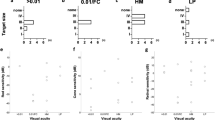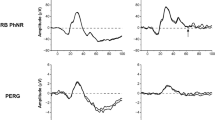Abstract
Purpose
The purpose of this study is to describe the relationships between full-field stimulus threshold (FST), electroretinography (ERG), and visual field (VF) outcomes in retinitis pigmentosa (RP).
Methods
Data from 47 patients with RP (n = 94 eyes) were evaluated. Patients were submitted to comprehensive ophthalmological examination including measurement of best-corrected visual acuity (BCVA), 30-2 threshold static VF, and microperimetry. Full-field ERG (ISCEV standard) was recorded, and achromatic FST was measured using a Diagnosys Espion system with the ColorDome™ LED full-field stimulator (Diagnosys LLC, Lowell, MA, USA).
Results
BCVA mean ± SD was 0.31 ± 0.03 logMAR, and FST mean ± SD was −18.45 ± 9.53 dB. No significant correlation was found between BCVA and FST. In contrast, statistically significant correlations were found between FST and static 30-2 VF mean deviation (r = −0.389; P < 0.01), microperimetry mean threshold (r = −0.607; P < 0.01). Dark and light-adapted ERGs were detectable in 28 and 48 eyes, respectively. Nevertheless, considering only the eyes with recordable ERG responses, moderate correlations were found between combined dark-adapted a-wave amplitude (r = −0.560; P < 0.01), b-wave amplitude (r = −0.643; P < 0.001), 30-Hz flicker response (r = −0.501; P < 0.01), and FST, and high correlation with FST for cone b-wave amplitude (r = −0.715; P < 0.01).
Conclusions
FST could be successfully determined in RP patients with a wide range of vision loss. FST results showed stronger correlations with full-field ERG amplitude than with sensitivity measured with visual field tests. FST is as an alternative to VF or ERG for assessment of retinal function in patients unable to do visual fields or with non-detectable ERGs.



Similar content being viewed by others
References
Hartong DT, Berson EL, Dryja TP (2006) Retinitis pigmentosa. Lancet 368:1795–1809
Zrenner E, Bartz-Schmidt KU, Benav H, Besch D, Bruckmann A, Gabel VP, Gekeler F, Greppmaier U, Harscher A, Kibbel S, Koch J, Kusnyerik A, Peters T, Stingl K, Sachs H, Stett A, Szurman P, Wilhelm B, Wilke R (2011) Subretinal electronic chips allow blind patients to read letters and combine them to words. Proc Biol Sci 278:1489–1497
Rizzo JF 3rd (2011) Update on retinal prosthetic research: the Boston Retinal Implant Project. J Neuroophthalmol 31:160–168
Humayun MS, Dorn JD, da Cruz L, Dagnelie G, Sahel JA, Stanga PE, Cideciyan AV, Duncan JL, Eliott D, Filley E, Ho AC, Santos A, Safran AB, Arditi A, Del Priore LV, Greenberg RJ, Argus IISG (2012) Interim results from the international trial of second sight’s visual prosthesis. Ophthalmology 119:779–788
Klauke S, Goertz M, Rein S, Hoehl D, Thomas U, Eckhorn R, Bremmer F, Wachtler T (2011) Stimulation with a wireless intraocular epiretinal implant elicits visual percepts in blind humans. Invest Ophthalmol Vis Sci 52:449–455
Siqueira RC, Messias A, Voltarelli JC, Scott IU, Jorge R (2011) Intravitreal injection of autologous bone marrow-derived mononuclear cells for hereditary retinal dystrophy: a phase I trial. Retina 31:1207–1214
Humayun MS, de Juan E Jr, del Cerro M, Dagnelie G, Radner W, Sadda SR, del Cerro C (2000) Human neural retinal transplantation. Investig Ophthalmol Vis Sci 41:3100–3106
Seiler MJ, Aramant RB (2012) Cell replacement and visual restoration by retinal sheet transplants. Prog Retin Eye Res 31:661–687
Beltran WA, Cideciyan AV, Lewin AS, Iwabe S, Khanna H, Sumaroka A, Chiodo VA, Fajardo DS, Roman AJ, Deng WT, Swider M, Aleman TS, Boye SL, Genini S, Swaroop A, Hauswirth WW, Jacobson SG, Aguirre GD (2012) Gene therapy rescues photoreceptor blindness in dogs and paves the way for treating human X-linked retinitis pigmentosa. Proc Natl Acad Sci USA 109:2132–2137
Hauswirth WW, Aleman TS, Kaushal S, Cideciyan AV, Schwartz SB, Wang L, Conlon TJ, Boye SL, Flotte TR, Byrne BJ, Jacobson SG (2008) Treatment of leber congenital amaurosis due to RPE65 mutations by ocular subretinal injection of adeno-associated virus gene vector: short-term results of a phase I trial. Hum Gene Ther 19:979–990
Schatz A, Rock T, Naycheva L, Willmann G, Wilhelm B, Peters T, Bartz-Schmidt KU, Zrenner E, Messias A, Gekeler F (2011) Transcorneal electrical stimulation for patients with retinitis pigmentosa: a prospective, randomized, sham-controlled exploratory study. Investig Ophthalmol Vis Sci 52:4485–4496
Talcott KE, Ratnam K, Sundquist SM, Lucero AS, Lujan BJ, Tao W, Porco TC, Roorda A, Duncan JL (2011) Longitudinal study of cone photoreceptors during retinal degeneration and in response to ciliary neurotrophic factor treatment. Investig Ophthalmol Vis Sci 52:2219–2226
Klein M, Birch DG (2009) Psychophysical assessment of low visual function in patients with retinal degenerative diseases (RDDs) with the diagnosys full-field stimulus threshold (D-FST). Doc Ophthalmol 119:217–224
Roman AJ, Schwartz SB, Aleman TS, Cideciyan AV, Chico JD, Windsor EA, Gardner LM, Ying GS, Smilko EE, Maguire MG, Jacobson SG (2005) Quantifying rod photoreceptor-mediated vision in retinal degenerations: dark-adapted thresholds as outcome measures. Exp Eye Res 80:259–272
Marmor MF, Fulton AB, Holder GE, Miyake Y, Brigell M, Bach M; International Society for Clinical Electrophysiology of V (2009) ISCEV standard for full-field clinical electroretinography (2008 update). Doc Ophthalmol 118:69–77
Meigen T, Bach M (1999) On the statistical significance of electrophysiological steady-state responses. Doc Ophthalmol Adv Ophthalmol 98:207–232
Lange C, Feltgen N, Junker B, Schulze-Bonsel K, Bach M (2009) Resolving the clinical acuity categories “hand motion” and “counting fingers” using the Freiburg Visual Acuity Test (FrACT). Graefes Arch Clin Exp Ophthalmol 247:137–142
Acknowledgments
Fundação de Amparo a Pesquisado Estado de São Paulo (FAPESP) Grant number: 2010/01714-9.
Conflict of interest
Katharina Messias: none; Herbert Jägle: none; Rafel Saran: none; André Domingos Pinto Ruppert: none; Rubens Siqueira: none; Rodrigo Jorge: none; Andre Messias: none.
Author information
Authors and Affiliations
Corresponding author
Rights and permissions
About this article
Cite this article
Messias, K., Jägle, H., Saran, R. et al. Psychophysically determined full-field stimulus thresholds (FST) in retinitis pigmentosa: relationships with electroretinography and visual field outcomes. Doc Ophthalmol 127, 123–129 (2013). https://doi.org/10.1007/s10633-013-9393-y
Received:
Accepted:
Published:
Issue Date:
DOI: https://doi.org/10.1007/s10633-013-9393-y




